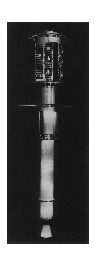
"An ingenious telescope in a satellite has provided the first view of
the universe at the shortest wavelength of the electromagnetic spectrum. This
historic glimpse is supplied by just 22 gamma rays."
With this subtitle to their 1962 "Gamman Ray Astronomy" article in
Scientific American, William L. Kraushaar and George W. Clark announced
to the world the start of gamma-ray astronomy from Earth-orbiting satellites.
Explorer 11 was the first gamma-ray detection satellite flown, weighing in at
82 pounds. It was launched on 27 April 1961 and the instrument aboard was
designed to detect gamma rays above 50 MeV. The satellite operated well until
early September, when power supply problems became noticeable. Useful data
ceased soon thereafter.
The gamma-ray detector was 20 inches high, 10 inches in diameter, and
weighed about 30 pounds. It consisted of a sandwich crystal scintillator
(CsI and NaI) and a Lucite Cerenkov counter, surrounded by a plastic
anticoincidence scintillator. The 2 detectors in coincidence served to
define the solid angle of the instrument to about 17 degrees half-angle.
The satellite could not be actively pointed, and so, was put into a tumble
in order to get a "rough" scan of the entire celestial sphere. By 19 May
1961, the satellite, located between 300 and 1100 miles above the Earth,
began to send sky survey data to the ground. Over the next 4 months, it
provided "nearly 20 miles of data on microfilm". Reconstruction of the data
allowed gamma-ray times of arrival to be determined to 0.1 second, and where
the detector was pointed to about 5 degrees.
Images of both the gamma-ray detector and schematics of its design are
included in the
Explorer-11 images page.
Over a period of 23 days, 9 hours of data from "pointing into
space" was obtained. In this data were found 22 events from gamma rays
and 22,000 events due to charged cosmic rays. It was noticed that the 22
events tended to have an asymmetrical distribution in the sky, with no
significant clustering near the galactic plane. The average directional
intensity of the events was J = 5.5e-4/sq-cm/sr/s.
- Kraushaar and Clark, 1962, May, Scientific American,
p.52
- Kraushaar and Clark, 1962, Phys Rev Lett,Vol. 8,No. 3,
p.106